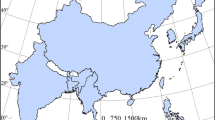Abstract
This paper generalizes the makeup and forming dynamic mechanism of natural disaster systems, principles and methods of comprehensive division of natural disasters, as well as structure, function and up-build routes of map and file information visualization system (MFIVS). Taking the Changjiang (Yangtze) Valley as an example, on the basis of revealing up the integrated mechanism on the formations of its natural disasters and its distributing law, thereafter, the paper relies on the MFIVS technique, adopts two top-down and bottom-up approaches to study a comprehensive division of natural disasters. It is relatively objective and precise that the required division results include three natural disaster sections and nine natural disaster sub-sections, which can not only provide a scientific basis for utilizing natural resources and controlling natural disaster and environmental degradation, but also be illuminated to a concise, practical and effective technique on comprehensive division.
Similar content being viewed by others
References
BI Si-wen, 1998. Earth System Science and Sustainable Development[M]. Beijing: Geological Publishing House, 198–231.
CHEN Xue-ying, MAO Zhen-pei, 1999. Grave Natural Disasters of Yangztze Valley and Their Prevention and Cure Countermeasure[M]. Wuhan: Hubei People Publishing House, 5–258. (in Chinese)
CHEN De-ji, YANG Pei-xue, 1998. Enrivonment geologic issue of exploitation and harness of Yangtze River[A]. In ZHANG Zhi-yi (ed). Environmental Geology[C]. Beijing: Geological Publishing House, 130–137.
CND (Committee on Natural Disasters), 1987. Confronting Natural[M]. Washington D C.: National Academy Press. 1–11.
LI Hong-ga, CHUI Wei-hong, 1999. Visualization of spatio-temporal multi-dimension data in GIS[J]. Journal of Remote Sensing, 3(2): 157–164.
LIU Rong-gao, 2000. Application-oriented geospatial data visualization[D]. A Ph.D dissertation submitted to the Institute of Geochemistry, CAS.
LUO Yuan-hua, ZHANG Liang, ZHANG Ye-cheng, 1998. Hazards Evaluation Method of Geologic Disasters[M]. Beijing: Geological Publishing House, 36–57, (in Chinese)
MA Zong-jin et al., 1990. Evalution, damage and countermeasure of natural disasters[A], In: Chinese Alleviation of Natural Disasters Study[C]. Beijing: Chinese Science and Technology Publishing House. (in Chinese)
MACEACHREN A, 1995. How Maps Work Representation, Visualization & Design[M]. New York: Guilford Press.
MARBLE D F, 1990. Geographic information systems: an overview. In: PECENQUET D J and D F MARBLE (eds.). Geographic Information Systems[M]. Taylor Fromceis, 8–17.
MEJIE M, NAVRRO M, WHOL E E, 1994. Geological hazard and rick evalution using GIS[J]. Bulletin of the Association of Engineering Geologists, (4): 21–30.
NE Gao-zhong, TANG Mao-cang, SU Gui-wu et al., 1999. Progresses in the research on multi-hazard correlation and the understding of comprehensive hazard-formation mechanism[J]. Quaternary Sciences, (5): 466–475. (in Chinese)
PETAK J W, ARTHUR A A, 1982. Natural Hazard Risk Assessment and Public Policy: Anticipating the Unexpected[M]. New York: Springer-Veerlagg Inc, 120–127, 138, 157, 109.
SHI Pei-jun, 1991. Theory and methodology on natural disasters study[J]. J Nanjing Univ. (Sci. & Tech.), 91(1): 37–42.
VAN Westen C J, ALSZATE Bonilla J B, 1990. Mountain hazard analysis using a PC-based GIS[A]. In: 6th Internal LAEG Congress.
WANG Jing-feng, 1994. Methodology for Assessing Natural Disaster Risk of China[M]. Beijing: Chinese Science and Technology Publishing House. 14–28. (in Chinese)
WANG Ping, SHI Pei-jun, 1999. The research of regional natural disaster regionalization with the “Bottom-up” methods[J]. Journal of Natural Disasters, 8(3): 54–60. (in Chinese)
WANG Si-jing, 1992. Enter into Chinese natural disasters and their hazards abatement stratagem[A]. In: CAS Geosciences Board. Situation of Disasters Analysis and Hazards Abatement Countermesures of Chinese Natural Disasters[C]. Wuhan: Hubei Science and Technology Publishing House, 94–99. (in Chinese)
YANG Kai-feng, HU Bao-qing, LI Xu et al., 2000. Applied study on map and file information visibility system (MFIVS) in the comprehensive division of mountainous area[J]. Journal of Mountain Science, 18 (6): 489–495. (in Chinese)
YU Su-hua, ZHAO Xiu-sheng, LIU Da-hai, 1999. Application of geographical information system(GIS) in Tarim Basin[J]. J. Tsinghua Univ. (Sci. & Tech.), 39(4): 122–124.
ZHANG Pi-yuan, WANG Feng-hui JIANG Hong et al., 1992. Probe into geographic distrubuting law of main natural disasters in China and their regional hazards abatement countermesures[A]. In: CAS Geosciences Board. Situation of Disasters Analysis and Hazards Abatement Countermesures of Chinese Natural Disasters[C]. Wuhan: Hubei Science and Technology Publishing House, 87–93, (in Chinese)
ZHANG Zhuo-yuan, LIU Han-chao, HUANG Run-qiu, 1997. Characteristics of geological environments in China and their restraints to engineering activities [J]. Journal of Geological Hazards and Environment Preservation, 8(1): 1–18.
Author information
Authors and Affiliations
Additional information
Foundation item: Under the auspices of President Foundation of the Chinese Academy of Sciences (1999).
Biography: HU Bao-qing (1966 -), male, a native of Linchuan, Jiangxi Province, Ph. D. His main research interests include environmental geology, mountain study, earth system science and sustainable development.
Rights and permissions
About this article
Cite this article
Hu, Bq., Mei-xin, J., Su-lan, J. et al. Application of map and file information visualization system to comprehensive division of natural disasters. Chin. Geograph.Sc. 11, 326–335 (2001). https://doi.org/10.1007/s11769-001-0048-7
Received:
Issue Date:
DOI: https://doi.org/10.1007/s11769-001-0048-7
Key words
- map and file information visualization system (MFIVS)
- natural disaster systems
- damage evaluation
- comprehensive division
- the Changjiang Valley




